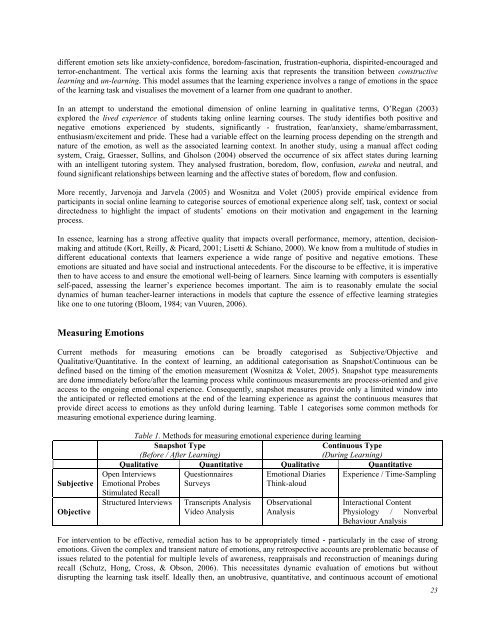October 2011 Volume 14 Number 4 - Educational Technology ...
October 2011 Volume 14 Number 4 - Educational Technology ...
October 2011 Volume 14 Number 4 - Educational Technology ...
Create successful ePaper yourself
Turn your PDF publications into a flip-book with our unique Google optimized e-Paper software.
different emotion sets like anxiety-confidence, boredom-fascination, frustration-euphoria, dispirited-encouraged and<br />
terror-enchantment. The vertical axis forms the learning axis that represents the transition between constructive<br />
learning and un-learning. This model assumes that the learning experience involves a range of emotions in the space<br />
of the learning task and visualises the movement of a learner from one quadrant to another.<br />
In an attempt to understand the emotional dimension of online learning in qualitative terms, O’Regan (2003)<br />
explored the lived experience of students taking online learning courses. The study identifies both positive and<br />
negative emotions experienced by students, significantly - frustration, fear/anxiety, shame/embarrassment,<br />
enthusiasm/excitement and pride. These had a variable effect on the learning process depending on the strength and<br />
nature of the emotion, as well as the associated learning context. In another study, using a manual affect coding<br />
system, Craig, Graesser, Sullins, and Gholson (2004) observed the occurrence of six affect states during learning<br />
with an intelligent tutoring system. They analysed frustration, boredom, flow, confusion, eureka and neutral, and<br />
found significant relationships between learning and the affective states of boredom, flow and confusion.<br />
More recently, Jarvenoja and Jarvela (2005) and Wosnitza and Volet (2005) provide empirical evidence from<br />
participants in social online learning to categorise sources of emotional experience along self, task, context or social<br />
directedness to highlight the impact of students’ emotions on their motivation and engagement in the learning<br />
process.<br />
In essence, learning has a strong affective quality that impacts overall performance, memory, attention, decisionmaking<br />
and attitude (Kort, Reilly, & Picard, 2001; Lisetti & Schiano, 2000). We know from a multitude of studies in<br />
different educational contexts that learners experience a wide range of positive and negative emotions. These<br />
emotions are situated and have social and instructional antecedents. For the discourse to be effective, it is imperative<br />
then to have access to and ensure the emotional well-being of learners. Since learning with computers is essentially<br />
self-paced, assessing the learner’s experience becomes important. The aim is to reasonably emulate the social<br />
dynamics of human teacher-learner interactions in models that capture the essence of effective learning strategies<br />
like one to one tutoring (Bloom, 1984; van Vuuren, 2006).<br />
Measuring Emotions<br />
Current methods for measuring emotions can be broadly categorised as Subjective/Objective and<br />
Qualitative/Quantitative. In the context of learning, an additional categorisation as Snapshot/Continuous can be<br />
defined based on the timing of the emotion measurement (Wosnitza & Volet, 2005). Snapshot type measurements<br />
are done immediately before/after the learning process while continuous measurements are process-oriented and give<br />
access to the ongoing emotional experience. Consequently, snapshot measures provide only a limited window into<br />
the anticipated or reflected emotions at the end of the learning experience as against the continuous measures that<br />
provide direct access to emotions as they unfold during learning. Table 1 categorises some common methods for<br />
measuring emotional experience during learning.<br />
Subjective<br />
Objective<br />
Table 1. Methods for measuring emotional experience during learning<br />
Snapshot Type<br />
Continuous Type<br />
(Before / After Learning)<br />
(During Learning)<br />
Qualitative Quantitative Qualitative Quantitative<br />
Open Interviews Questionnaires Emotional Diaries Experience / Time-Sampling<br />
Emotional Probes<br />
Stimulated Recall<br />
Surveys<br />
Think-aloud<br />
Structured Interviews Transcripts Analysis Observational Interactional Content<br />
Video Analysis Analysis<br />
Physiology / Nonverbal<br />
Behaviour Analysis<br />
For intervention to be effective, remedial action has to be appropriately timed - particularly in the case of strong<br />
emotions. Given the complex and transient nature of emotions, any retrospective accounts are problematic because of<br />
issues related to the potential for multiple levels of awareness, reappraisals and reconstruction of meanings during<br />
recall (Schutz, Hong, Cross, & Obson, 2006). This necessitates dynamic evaluation of emotions but without<br />
disrupting the learning task itself. Ideally then, an unobtrusive, quantitative, and continuous account of emotional<br />
23

















